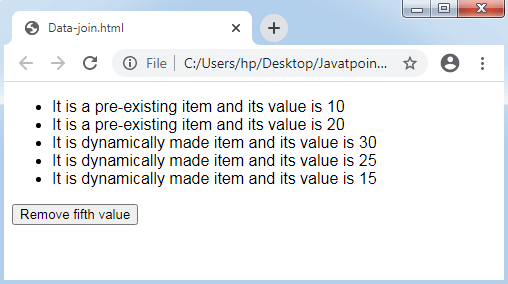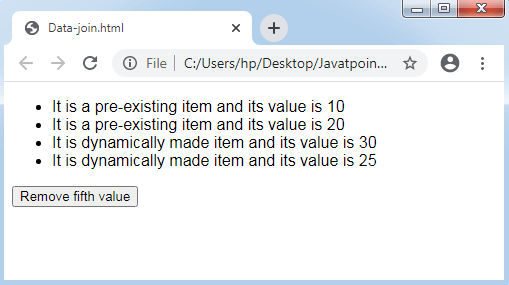Data Join in D3.js
D3.js has another essential concept, i.e., Data join. It implements with the selections and supports us to employ the document of HTML for our data set (collection of the numerical values). D3.js provides the highest priority data set inside every component in a data set related to HTML documents and its methods, by default. Further, we will learn the data join concept in detail.
What is the Data Join?
The concept of D3.js supports us in removing, modifying, and injecting the items (items of HTML and items of SVG as well) based on a data set inside an existing document of HTML. Every data element in a data set relates to an item (graphical) within the document, by default.
As we know that any data set modifies, the related item may also be employed quickly. The data join makes a close connection among the document’s graphical items and our data. The data join builds item’s manipulation (based on a data set) easy and straightforward process.
How did it Work?
The data join’s main aim is the item’s mapping of an existing document inside any provided data set. The data join can make the document’s virtual representation according to the provided data set. It gives techniques to execute with a virtual representation.
Let’s understand a general data which is shown below:
The above data set contains five items so that it could be mapped with five components of a document.
Let’s map it to a <li> tag of the documents with the use of the selectAll() method of selector and data() method of the data join.
HTML
Code of D3.js
Here are five items as virtual inside a document. Any first two items as virtual are any two <li> items inside a document as depicted below:
We may apply every items of the selector changing techniques such as text(), style(), and attr() for any first two items of <li> as depicted below:
The function inside the text() method can be applied to get mapped data of <li> item. In the above code, d defines 10 of the first <li> item and 20 of second <li> item.
The remaining three items could be mapped with any items. It could be possible with the help of the enter() method of data join and append() method of the selector. An enter() provides us to access any remaining data (not mapped with an existing item), and an append() provides the facility to make any new item from the related data.
Let’s make <li> element for the items of remaining data. A data map can be as follows:
The code for making a new <li> item is shown below:
The data join gives another technique known as exit() method for processing the data elements removed from a data set dynamically as depicted below:
We have removed the 4th element from the above data set, and related <li> with the help of the remove() and exit() methods.
The entire code can be as follows:
Example:
Output:

After removing fifth item-

